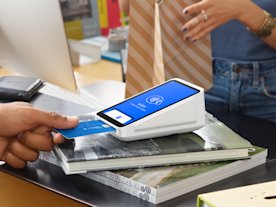Offline card processing makes sure you never miss a sale, no matter your Wi-Fi connection.
Maybe there’s a certain spot in your shop with patchy internet, or you’re often selling on the go where Wi-Fi can be hard to come by. Offline card processing means you can continue to accept magnetic-stripe (swipe), contactless (tap) and chip-and-pin (dip) payments, despite your limited connectivity.
As the most popular payment method in Ireland, accounting for 64% of transactions in 2020, card payments are a vital part of your selling model.
Read on to find out more about offline card processing and how it can ensure your business is ready to sell in every environment.
What is offline credit card processing?
Usually, if your internet connection is slow, patchy or unavailable, your card machine is unable to process any transactions, which can result in lost sales. That’s where offline credit card processing can help.
With offline card processing, you can continue to accept payments while your Wi-Fi connection is down. Any offline payments during this downtime will then be processed automatically once your device regains connectivity.
This offline functionality can have a huge impact on your sales, as it means you don’t have to worry about connectivity issues. And as card payments continue to increase – by 79% in Ireland between 2016 and 2020 – being able to accept card sales while offline is becoming more and more important.
In Ireland, chip-and-pin transactions are the most common type, with some businesses accepting swipe cards in exceptional circumstances. So, ensuring your point-of-sale system can cater for all forms of offline card processing is essential.
How do Offline Payments help your business?
Square’s offline payments give your business more flexibility when selling. It can particularly benefit pop-up and mobile businesses that are frequently changing their location, or often find themselves in remote locations, such as festivals and markets.
Offline card processing also adds an extra degree of certainty for both business owners and their customers. You can rely on Square Terminal to process a card transaction, even if the internet is down. There’s no need to note down card details to process later – a big security risk – and you don’t have to cancel transactions if your customer can’t pay by cash. Not only does this secure sales, but also helps build trust in your brand.
How to manage offline payments
To set up offline payments on your Square Terminal, you’ll need to follow these simple steps:
- Head to the navigation bar at the bottom of your screen and click More.
- Go to Settings > Checkout > Offline Payments.
- Turn on Allow Offline Payments.
- Review and confirm that you want to Allow Offline Payments.
- Optional: Set a Per Transaction Limit for any offline card transactions – it’s automatically set at €100.
Once you’ve enabled offline card processing, the Square app will automatically allow offline payments if your internet is disrupted or disconnected. A red banner will appear to let you know you’re allowing offline payments.
Any card transactions made while offline will appear as pending on your payment history until your device reconnects to the internet. As soon as you reconnect, they’ll be processed automatically, and your customer should then receive their digital receipt and payment notification email.
Are there any risks?
Offline payments do not pose any security risks to you or your customers. Whether online or offline, all Square transactions are encrypted to protect card details.
For offline use, Square POS goes one step further with encrypted transaction data. This ensures all details are secure and protected until the payment device is back online and the data reaches our PCI DSS-compliant environment. It will then be deleted from the device.
While offline credit card processing is secure, there are some things to bear in mind when using Square’s offline payments:
-
Offline payments will expire if not processed within 72 hours, so ensure you reconnect to the internet within this time to complete the process.
-
Do not delete the Square app if you have pending offline payments, as they will be permanently lost.
-
You can’t cancel or refund pending offline payments. Instead, you’ll need to reconnect your device to the internet so the payments can automatically upload. You can then issue a refund.
-
You’re responsible for any expired, declined or disputed payments accepted while accepting offline payments.
How to protect your business
One of the best ways to protect your business when using offline payments is to set a limit for offline transactions. When enabled, offline payments set a default transaction limit of €100. You can change this to suit your business, up to a maximum limit of €50,000 per transaction.
You’re responsible for any expired, declined or disputed payments accepted with offline payments. So, if the card has been declined, check it hasn’t expired first and confirm the name of the cardholder to ensure it’s valid.
Similarly, for swipe card payments, you should obtain a signature and compare it with the signature on the screen to verify the card.
